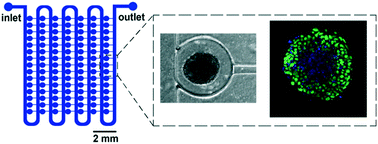Our official English website, www.x-mol.net, welcomes your feedback! (Note: you will need to create a separate account there.)
A microfluidic trap array for longitudinal monitoring and multi-modal phenotypic analysis of individual stem cell aggregates
Lab on a Chip ( IF 6.1 ) Pub Date : 2017-09-19 00:00:00 , DOI: 10.1039/c7lc00763a E. L. Jackson-Holmes 1, 2, 3, 4 , T. C. McDevitt 4, 5, 6, 7, 8 , H. Lu 1, 2, 3, 4, 9
Lab on a Chip ( IF 6.1 ) Pub Date : 2017-09-19 00:00:00 , DOI: 10.1039/c7lc00763a E. L. Jackson-Holmes 1, 2, 3, 4 , T. C. McDevitt 4, 5, 6, 7, 8 , H. Lu 1, 2, 3, 4, 9
Affiliation

|
Three-dimensional pluripotent stem cell (PSC) cultures have the ability to undergo differentiation, self-organization, and morphogenesis to yield complex, in vitro tissue models that recapitulate key elements of native tissues. These tissue models offer a system for studying mechanisms of tissue development, investigating disease mechanisms, and performing drug screening. It remains challenging, however, to standardize PSC aggregate differentiation and morphogenesis methods due to heterogeneity stemming from biological and environmental sources. It is also difficult to monitor and assess large numbers of individual samples longitudinally throughout culture using typical batch-based culture methods. To address these challenges, we have developed a microfluidic platform for culture, longitudinal monitoring, and phenotypic analysis of individual stem cell aggregates. This platform uses a hydrodynamic loading principle to capture pre-formed stem cell aggregates in independent traps. We demonstrated that multi-day culture of aggregates in this platform reduces heterogeneity in phenotypic parameters such as size and morphology. Additionally, we showed that culture and analysis steps can be performed sequentially in the same platform, enabling correlation of multiple modes of analysis for individual samples. We anticipate this platform being applied to improve abilities for phenotypic analysis of PSC aggregate tissues and to facilitate research in standardizing culture systems in order to dually increase the yield and reduce the heterogeneity of PSC-derived tissues.
中文翻译:

用于单个干细胞聚集体的纵向监测和多模式表型分析的微流体阱阵列
三维多能干细胞(PSC)培养物具有体外分化,自组织和形态发生的能力,可产生复杂的体外概括天然组织关键要素的组织模型。这些组织模型提供了一个用于研究组织发育机制,研究疾病机制和进行药物筛选的系统。然而,由于生物和环境来源的异质性,标准化PSC聚集体分化和形态发生方法仍然具有挑战性。使用典型的基于批次的培养方法在整个培养过程中纵向监测和评估大量单个样品也很困难。为了解决这些挑战,我们开发了一种微流体平台,用于单个干细胞聚集体的培养,纵向监测和表型分析。该平台使用流体动力学加载原理来捕获独立陷阱中的预制干细胞聚集体。我们证明了在此平台上聚集体的多日培养可以减少表型参数(例如大小和形态)的异质性。此外,我们展示了可以在同一平台上顺序执行培养和分析步骤,从而使单个样品的多种分析模式相互关联。我们预计该平台可用于提高PSC聚集组织的表型分析能力,并促进标准化培养系统的研究,从而双重提高产量并降低PSC衍生组织的异质性。支持对单个样品的多种分析模式进行关联。我们预计该平台将用于提高PSC聚集组织的表型分析能力,并促进标准化培养系统的研究,以双重提高产量并降低PSC衍生组织的异质性。支持对单个样品的多种分析模式进行关联。我们预计该平台将用于提高PSC聚集组织的表型分析能力,并促进标准化培养系统的研究,以双重提高产量并降低PSC衍生组织的异质性。
更新日期:2017-10-26
中文翻译:

用于单个干细胞聚集体的纵向监测和多模式表型分析的微流体阱阵列
三维多能干细胞(PSC)培养物具有体外分化,自组织和形态发生的能力,可产生复杂的体外概括天然组织关键要素的组织模型。这些组织模型提供了一个用于研究组织发育机制,研究疾病机制和进行药物筛选的系统。然而,由于生物和环境来源的异质性,标准化PSC聚集体分化和形态发生方法仍然具有挑战性。使用典型的基于批次的培养方法在整个培养过程中纵向监测和评估大量单个样品也很困难。为了解决这些挑战,我们开发了一种微流体平台,用于单个干细胞聚集体的培养,纵向监测和表型分析。该平台使用流体动力学加载原理来捕获独立陷阱中的预制干细胞聚集体。我们证明了在此平台上聚集体的多日培养可以减少表型参数(例如大小和形态)的异质性。此外,我们展示了可以在同一平台上顺序执行培养和分析步骤,从而使单个样品的多种分析模式相互关联。我们预计该平台可用于提高PSC聚集组织的表型分析能力,并促进标准化培养系统的研究,从而双重提高产量并降低PSC衍生组织的异质性。支持对单个样品的多种分析模式进行关联。我们预计该平台将用于提高PSC聚集组织的表型分析能力,并促进标准化培养系统的研究,以双重提高产量并降低PSC衍生组织的异质性。支持对单个样品的多种分析模式进行关联。我们预计该平台将用于提高PSC聚集组织的表型分析能力,并促进标准化培养系统的研究,以双重提高产量并降低PSC衍生组织的异质性。



























 京公网安备 11010802027423号
京公网安备 11010802027423号